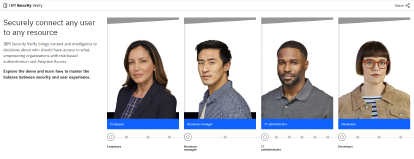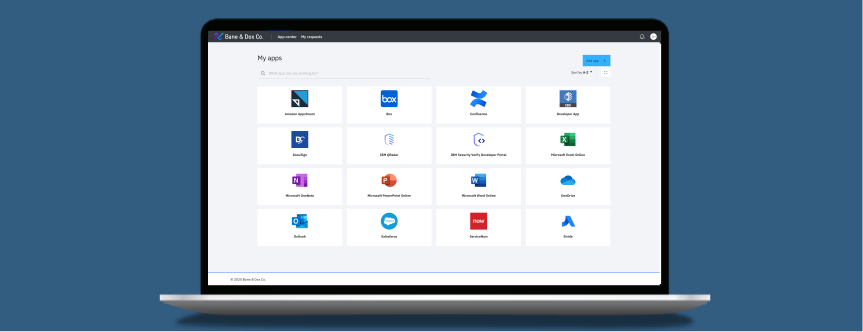Authenticate consumer and employee digital identities seamlessly
Transform your IAM program with identity-as-a-service
Table of contents
Table of contents
Key points
Validating user identities
“Securing identity online” is a phrase heard time and time again in the technology industry. Most organizations have implemented automated measures to validate user identities and protect their critical assets from attack. Yet many organizations still experience breaches or at the very least lack internal efficiency, which begs the question: What’s missing?
Digital identity-related breaches are a top driver of consumer data loss, including personal information and financial loss, and internal company data loss, such as access to records and internal controls. The average cost of a data breach is $3.86 million, taking an average of 280 days to identify and contain.1 Companies that are breached don’t just lose data, they can lose public trust. After a security breach, consumers often view affected companies as less than trustworthy, which can lead to business loss.
As more companies migrate to the cloud, companies search for security measures to authorize and authenticate internal and external users, but they do not want to negatively impact the user journey with troublesome authentication methods. Identity-as-a-service is expected to grow at a compound annual rate of 14.1% over the next few years as more businesses look to reap the benefits of cloud computing.2 The goal for companies is to validate the identities of both consumers and employees from the cloud, but in a seamless and painless manner for users.
After a security breach, consumers often view affected companies as less than trustworthy.
Secured and seamless made simple
Organizations today aim to implement zero trust strategies with identity as a central pillar. These implementations need to have secure processes while simultaneously offering all users a frictionless, productive experience. To provide these experiences, organizations should:
Confirm identities using context
Companies must be able to confirm and authorize all users logging in and provide continuous authentication throughout the user journey. They must be able to correctly and discreetly identify users without negatively impacting the user experience by implementing risk-based authentication.
Monitor authentication events
Identifying suspicious patterns of behavior is now a major challenge in the industry. To diagnose a fraudulent user, organizations need insight into all user activity as well as the ability to identify when unusual user behavior occurs and automatically take action.
Enforce security across digital platforms
Organizations are increasing mobile usage every day. As a result, more and more mobile devices need extended protection across applications, IoT and unified endpoint management. Companies are faced with the challenge of addressing growing mobile usage that requires digital identity enforcement and protection anywhere.
Companies must be able to confirm and seamlessly authorize all users logging in and provide continuous authentication throughout the user journey.

Access Requests with IBM Security Verify
IBM Security Verify helps organizations deliver fast, secured access to business applications. See how IBM’s IDaaS technology connects users and apps in this two-minute video.
Taking the pain out of passwords
Securing a user’s digital identity — whether an internal employee, partner or customer — is a challenge for businesses. Customers in particular want to make sure their digital identities are secure when using any application, but they also want an easy-to-use, painless experience.
Complex security measures
Security is key for customers to trust any organization. Users, however, do not want to see or interact with complex security measures — they expect that the security part of applications will run in the background and not be an inconvenience.
Keeping track of multiple usernames and passwords
Customers are faced with the challenge of remembering multiple usernames and passwords for each application they use. Each application that needs a separate set of log-in credentials serves as a negative blocker for the user.
Establish progressive trust
Users want a streamlined process, but they also do not want to provide more personal data than necessary. They expect to provide an appropriate level of data based on the transaction at hand, with the organization progressively learning more about a user throughout their journey.
Users expect that the security part of applications will run in the background and not be an inconvenience.

Single sign-on (SSO) options
Multifactor authentication (MFA)
Risk-based authentication and adaptive access
User lifecycle management
Connections with existing user directories and identity providers
Integrations for zero trust initiatives
Support for consumer IAM scenarios
Expertise to make your program successful
Identity Analytics with IBM Security Verify
IBM Security Verify helps businesses analyze risks across their IAM environment. See how IBM’s IDaaS technology identifies risks and offers suggested remediation in this short video.
IBM Security Verify
The IBM Security Verify solution allows IT, security and business leaders to protect their digital users, assets and data in a hybrid multicloud world, while promoting internal process efficiency along the way. Beyond SSO and MFA, Verify is a modernized, modular IDaaS that provides AI-powered context for adaptive access decisions, guided experiences for developer consumability and comprehensive cloud capabilities, including access recertification and identity analytics. Future-proof your identity and access management investment for both workforce and consumer populations with Verify.
Next steps

Simplify and accelerate user productivity with Verify
Launch the interactive demo and discover firsthand the workflows within Verify.

Secure employee productivity with born-in-the-cloud IDaaS
Learn more about Verify’s features, benefits and use cases.

Download the e-book
Save and share this document with colleagues.
Sources
-
2020 Cost of a Data Breach Report. Conducted by the Ponemon Institute.
Sponsored by IBM Security. -
Forrester Analytics: IAM Software Forecast, 2018 To 2023 (Global). Forrester Research, Inc.
May 10, 2019. Sponsored by IBM.
Table of contents
Validating user identities
Validating user identities
“Securing identity online” is a phrase heard time and time again across industries. Most companies implement extensive measures to validate user identities and protect their critical assets from attack, however, breaches and attacks still pose a threat.
Digital identity-related breaches are a top driver of consumer data loss, including personal information and financial loss, and internal company data loss, such as access to records and internal controls. The average cost of a data breach is $3.92 million and the average size of a data breach is 25,575 records.1 Companies that are breached don’t just lose data, they can lose public trust. After a security breach, consumers often view affected companies as less than trustworthy, which can lead to business loss.
As more companies migrate to the cloud, the search continues for security measures to authorize and authenticate internal and external users without negatively impacting the user journey. Identity-as-a-Service is expected to grow at a compound annual rate of 14.1% over the next five years as more businesses look to reap the benefits of cloud computing.2 The goal for companies is to have identity validation for consumers and employees, but in a seamless and painless manner.
After a security breach, consumers often view affected companies as less than trustworthy.
Seamless made simple
Secured and seamless made simple
Organizations today aim to implement zero trust strategies with identity as a central pillar. These implementations need to have secure processes while simultaneously offering all users a frictionless, productive experience. To provide these experiences, organizations should:
Confirm identities using context
Companies must be able to confirm and authorize all users logging in and provide continuous authentication throughout the user journey. They must be able to correctly and discreetly identify users without negatively impacting the user experience by implementing risk-based authentication.
Monitor authentication events
Identifying suspicious patterns of behavior is now a major challenge in the industry. To diagnose a fraudulent user, organizations need insight into all user activity as well as the ability to identify when unusual user behavior occurs and automatically take action.
Enforce security across digital platforms
Organizations are increasing mobile usage every day. As a result, more and more mobile devices need extended protection across applications, IoT and unified endpoint management. Companies are faced with the challenge of addressing growing mobile usage that requires digital identity enforcement and protection anywhere.
Companies must be able to confirm and seamlessly authorize all user interactions and provide continuous authentication throughout the user journey.

Poll
What are the challenges with your identity management solution?
Please select one
Infrastructure costs
Time and cost of deployment
Managing continuous updates
Access Requests with IBM Security Verify
IBM Security Verify helps organizations deliver fast, secured access to business applications. See how IBM’s IDaaS technology connects users and apps in this two-minute video.
Taking the pain out of passwords
Taking the pain out of passwords
Securing a user’s digital identity — whether an internal employee, partner or customer — is a challenge for businesses. Customers in particular want to make sure their digital identities are secure when using any application, but also want an easy-to-use, painless experience.
Complex security measures
Security is key for customers to trust any organization. Users, however, do not want to see or interact with complex security measures — they expect that the security part of applications will run in the background and not be an inconvenience.
Keeping track of multiple usernames and passwords
Customers are faced with the challenge of remembering multiple usernames and passwords for each application they use. Each application that needs a separate set of log-in credentials serves as a negative blocker for the user.
Establish progressive trust
Users want a streamlined process, but they also do not want to provide more personal data than necessary. They expect to provide an appropriate level of data based on the transaction at hand, with the organization progressively learning more about a user throughout their journey.
Users expect that the security part of applications will run in the background and not be an inconvenience.

Poll
Does your company have plans to go password-less in the next year?
Please select one
Already incorporated password-less technology
Interested in becoming password-less
Not interested
What to look for in an identity and access management (IAM) solution
Single sign-on (SSO) options
Multifactor authentication (MFA)
Risk-based authentication and adaptive access
User lifecycle management
Connections with existing user directories and identity providers
Integrations for zero trust initiatives
Support for consumer IAM scenarios
Expertise to make your program successful
Identity Analytics with IBM Security Verify
IBM Security Verify helps businesses analyze risks across their IAM environment. See how IBM’s IDaaS technology identifies risks and offers suggested remediation in this short video.
IBM Security Verify
IBM Security Verify
The IBM Security Verify solution allows IT, security and business leaders to protect their digital users, assets and data in a hybrid multicloud world, while promoting internal process efficiency along the way. Beyond SSO and MFA, Verify is a modernized, modular IDaaS that provides AI-powered context for adaptive access decisions, guided experiences for developer consumability and comprehensive cloud capabilities, including access recertification and identity analytics. Future-proof your identity and access management investment for both workforce and consumer populations with Verify.
Next steps
Next steps

Simplify and accelerate user productivity with Verify
Launch the interactive demo and discover firsthand the workflows within Verify.

Secure employee productivity with born-in-the-cloud IDaaS
Learn more about Verify’s features, benefits and use cases.

Download the e-book
Save and share this document with colleagues.
Sources
Sources
-
2020 Cost of a Data Breach Report. Conducted by the Ponemon Institute.
Sponsored by IBM Security. -
Forrester Analytics: IAM Software Forecast, 2018 To 2023 (Global). Forrester Research, Inc.
May 10, 2019. Sponsored by IBM.